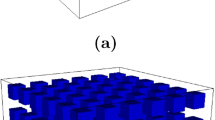Abstract
We describe an algorithm for computing the motion of a solid-liquid interface in 2D, which is applicable to geological pressure solution or to pressure sintering. The backward motion (toward the solid) of the interface is due to dissolution of the solid, and the forward motion (away from the solid) is due to the inverse process of reprecipitation. The interface velocity is assumed proportional to the difference between the solubility of the solid and the concentration of the solution. The former is dependent upon stress (the phenomenon of “pressure solution”), so our algorithm must also keep track of the stress. We use a Lagrangian grid, with constant-stress periodic boundary conditions. The method has been applied to porosity reduction in sandstone. It is applicable to other interface-following problems, such as freezing, if the motion is slow enough that heat transport is not rate-limiting.
Similar content being viewed by others
References
D. A. Kessler, Joel Koplik, and Herbert Levine, in Computer Simulation of Microstructural Evolution, edited by David J. Srolovitz (The Metallurgical Society, 1986), p. 95.
V.Y. Novikov, Acta Metall. 26, 1739–1744 (1978).
O. Hunderi and N. Ryum, Acta Metall. 27, 161–165 (1979); 29, 1737–1745 (1981).
D. Ronis, D. Bedeaux, and I. Oppenheim, Physica 90A, 487 (1978).
D. Ronis and I. Oppenheim, Physica 117A, 317 (1983).
D. J. Srolovitz, M. P. Anderson, G. S. Grest, and P. S. Sahni, Scripta Metall. 17, 241–246 (1983).
G.S. Grest, M.P. Anderson, and D.J. Srolovitz, in Computer Simulation of Microstructural Evolution, edited by David J. Srolovitz (The Metallurgical Society, 1986).
A problem to which one might apply this sort of algorithm is the application of real-space scale-coarsening (RNG) techniques which describe fluid dynamics well far from phase transitions [P. B. Visscher, J. Stat. Phys. 38, 989 (1985)] to systems near critical points, where the well-established discrete-cell description works well for small cells, but needs to incorporate interface motion in order to describe large cells.
D. F. Sibley and H. Blatt, J. Sed. Petrology 46, 881–896 (1976).
R. B. de Boer, P. J. C. Nagtegaal, and E. M. Duyvis, Geochim. Cosmochim. Acta 41, 257–264 (1977).
E. S. Sprunt and Amos Nur, Geophysics 42, 726–741 (1977).
P. K. Weyl, J. Geophys. Res. 64, 2001–2025 (1959).
R. G.C. Bathurst, Liverpool Manchester Geological Journal 2, 11–36 (1958).
R.G.C. Bathurst, Carbonate Sediments and Their Diagenesis, 2nd ed. (Elsevier, Amsterdam, 1976).
E. H. Rutter, Philos. Trans. R. Soc. London, Ser. A 283, 203–219 (1976).
P. F. Robin, Geochim. Cosmochim. Acta 42, 1383–1389 (1978).
C. L. Angevine and D. L. Turcotte, Geo. Soc. of Am. Bull. 94, 1129–1134 (1983).
Near zero pressure, the pressure dependence should be quadratic [M. S. Paterson, Rev. Geophysics and Space Physics 11, 355–389 (1978)], but linearizing about some large average pressure gives the linear form we use. There is some discussion in the geological literature of possible dependence of the solubility on the shear stress: see R. B. de Boer, Geochim. Cosmochim. Acta 41, 249–256 (1977); P.F. Robin, Geochim. Cosmochim. Acta 42, 1383–1389 (1978) and references therein.
M. R. Hubbert and W.W. Rubey, GSA Bull. 70, 115 (1959).
W. F. Brace, in Flow and Fracture of Rocks, AGU Geophys. Monogr. Ser. 16, edited by H. C. Heard, I.Y. Borg, N.L. Cantor, and C. B. Rayleigh, 265 (1972).
M. H. Cohen and M. P. Anderson, in Chemistry and Physics of Composite Media, edited by M. Tomkiewicz and P.W. Sen, Proc. Volume 84-8, J. Electrochemical Society, p. 133 (1986); M.H. Cohen, AIP Conf. Proc. 154, Physics and Chemistry of Porous Media II, edited by J. R. Banavar, J. Koplik, and K.W. Winkler, American Institute of Physics, p. 3 (1987).
We have taken the bulk and shear moduli to be the same to simplify the calculation, because the exact values of the elastic constants are not critical in this simulation (elasticity is included mostly as a mechanism for modeling the stress concentration around grain contacts; we have used the nominal value E = 1010 N/m2). We could relax this assumption by using the method of Eqs. (10) and (11) to calculate the strain tensor, and multiplying appropriate components by elastic moduli to obtain the stress tensor and hence the force on each volume element (lattice point). However, this introduces complications when not all neighbors of a lattice point are solid, since the force across a bond depends on the displacements of other bonds. Equation (6) has the advantage that the force on a bond can be computed from its displacement alone.
J. Glimm, J. Grove, B. Lindqvist, O. A. McBryan, and G. Tryggvason, SIAM J. Sci. Stat. Comput. 9, 61–79, 1988.
J. Glimm, B. Lindqvist, O.A. McBryan, and G. Tryggvason, Sharp and Diffuse Fronts in Oil Reservoirs: Front Tracking and Capillarity, Proc. on Mathematical and Computational Methods in Seismic Exploration and Reservoir Modelling, Houston, SIAM, Philadelphia, PA, January 1985.
J. R. Ray and A. Rahman, J. Chem. Phys. 80, 4423 (1984).
G.C. Kennedy, Econ. Geol. 5, 629–653 (1950).
P. B. Visscher, J. H. Fang, and J. C. Cates (unpublished research).
D.W. Houseknecht, AAPG Bulletin 71, 633 (1987), Fig. 2(a).
J. M. Chaix, M. Guyon, J. Rodriguez, and C. H. Allibert, Scripta Metall. 22, 71 (1988).
H. J. Frost, C.V. Thompson, C. L. Howe, and J. Whang, Scripta Metall. 22, 65 (1988).
Author information
Authors and Affiliations
Rights and permissions
About this article
Cite this article
Visscher, P.B., Cates, J.E. Simulation of porosity reduction in random structures. Journal of Materials Research 5, 2184–2196 (1990). https://doi.org/10.1557/JMR.1990.2184
Received:
Accepted:
Published:
Issue Date:
DOI: https://doi.org/10.1557/JMR.1990.2184




